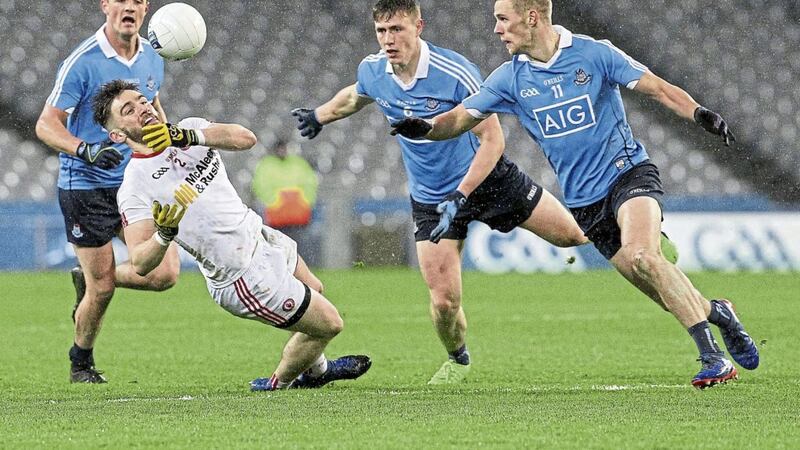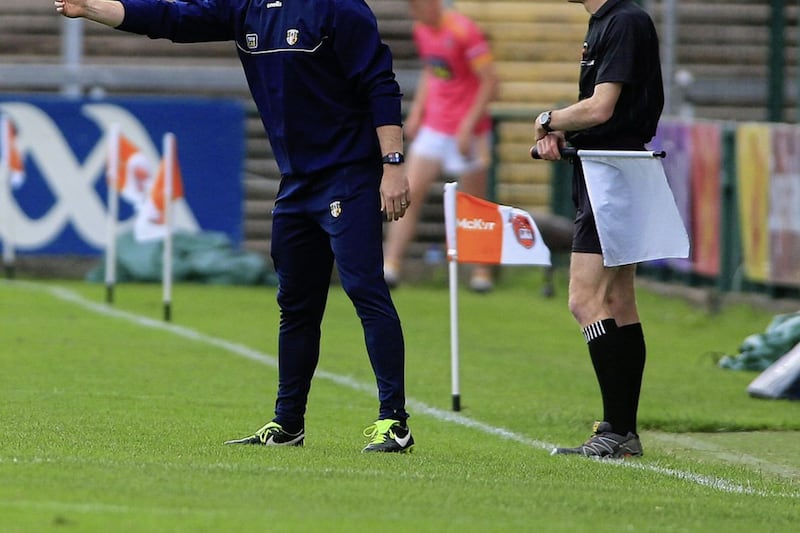LIKE the cold or the flu, the two-tiered football Championship is something that just seems to keep doing the rounds.
It is once again on the agenda following Paraic Duffy’s final statement as GAA director-general.
The virtues of the two-tiered system are always brought home to me when I scan the list of fixtures at the start of the National League.
Countless ‘last man standing’ competitions are up and running among GAA fans, where the aim of the game is to pick a winner in each round of fixtures.
When trying to back a definite winner out of the eight games across Divisions One and Two this week, I found myself struggling to back anyone bar Dublin. It’s no easier for Divisions Three and Four.
Compare this to the Championship, where the old clichés of anyone winning on any given day are usually found well off the mark with numerous ties foregone conclusions.
In comparison, the result of every game this weekend is up for grabs as it will be throughout the League.
When the League is wrapped up we head into the general procession that most of the provincial competitions and Qualifiers have become until we hit the quarter-final stage.
It’s abundantly clear then (and let’s face it, not exactly revolutionary), that the best competition is when teams of similar levels play each other.
The National League, as good a competition as it has become, is, however, still a clear second to the Championship.
This year I think the top teams will be seeing the League as key preparation ground for the new ‘Super 8’ Championship format.
For those teams with strongest chances of being in the last eight – think all your Division One sides and a handful of the Division Two sides – the League will be a key building ground for developing a panel of players capable of surviving what could be a very testing time in July/August.
Over five weeks from mid-July, they will play three ‘all-quarter-final’ ties and, if successful, their All-Ireland semi-final.
That will demand a quality panel to deal with the fatigue, injuries and suspensions during that time. Any of the top teams will realistically need to have found 20-24 strong Championship level footballers capable of making a difference in the very biggest of games. That means lads need to be found and trusted now in the National League.
All the top teams bar Dublin are pretty reliant on a core group of 10 or 12 players. They will need to find more, otherwise the increased frequency of high intensity games looming this year will only make the strongest stand out even more. And we all know who that means.
--
AWAY from the pitch there are significant plays being made within conversation with the obvious aim of influencing the environment surrounding the appointment of a replacement for Paraic Duffy as director-general of the GAA.
This is without doubt the single most powerful post in the GAA.
As a full-time employee, it is a position that can set an agenda and bring it to fruition.
This is because, in the world of GAA diplomacy and red tape, policies and changes in structure take time to make happen.
The current big changes to Championship and underage structures at county level may have seemed to happen all of a sudden across the last two Congresses. But in reality, they have been five-10 years in development.
They only came about following several reports, much sub-committee work, much aligning of the influential bodies at Congress and indeed many more failed motions rather than successful ones over the previous five years.
All the while, though, small victories led the way for the bigger changes passed more recently.
The GAA president, on the other hand, often comes to office with the very highest of ideals, but as they are only in the position for three years, they usually only get a fraction of the things done they may have wanted to do.
No one would argue that there are not big and difficult issues within the GAA, but listening to some of the commentary would make me despair.
Some urge turning away almost completely from the county game, distilling it down to a two or a four-month season and turning all attention to the clubs. This is playing for the populist vote. They argue that the county game is ‘destroying the clubs’ and causing the ‘fixture crisis’, that it is driving ‘elitism’ which is poisoning the very soul of the association, so much so that we have greater numbers than ever walking away from the game.
It is dramatic stuff. It is the equivalent of standing on a soap box shouting the end is nigh.
‘Facts’ are being fired about which have about the same veracity as a statement from Donald Trump (left).
The populist opinions of the county game destroying the clubs has never in any way been tested. And even an initial look at other influences or backgrounds would give anyone with a touch of logic and sensible analysis cause to pause for thought.
I remember well the time when the Irish international soccer team was in its pomp and rugby was turning professional.
Fears for the GAA abounded over being able to compete with the prestige of these sports in the minds of our young players.
Now we fear elitism is putting all the emphasis on the county game and ruining clubs and that somehow by restricting the county game we will all go back to some halcyon amateur day of a match and a pint.
The increased intensity of preparation and lack of fixtures is often said to be making players turn away in droves.
Aside from the fact we have no comparative data for player drop-out (thus the ‘facts’ are anything but factual), does anyone really think that the preparation levels will drop if the club games are given proper importance and time. I would presume the opposite would occur. Another great line of attack is that the ‘suits’ in Croke Park are too powerful and too detached from the clubs to actually care.
Yet, later in the same discussions, when the reality is admitted that, in plenty of counties, club competitions are organised reasonably well and that those that are a bit of a shambles are due primarily to the county board’s ineptitude, the argument surfaces that it is Croke Park’s fault for not taking ownership of club fixtures and the need for them to hold county boards to account.
So somehow the cure for the ‘crisis’ is to hand total control of club fixtures to those people that we feel are too removed and don’t care about the club game in the first place. Interesting.
I’m not saying there are no problems. No one is, but if we learn anything from the votes on Brexit or Trump, we should see that when debates of huge importance become filled with dubious facts, ‘fake news’ or soundbites, some pretty radical things like Brexit and Trump become realities.
Surely, we owe it to ourselves in the GAA to have reasoned debates based on sound facts.






